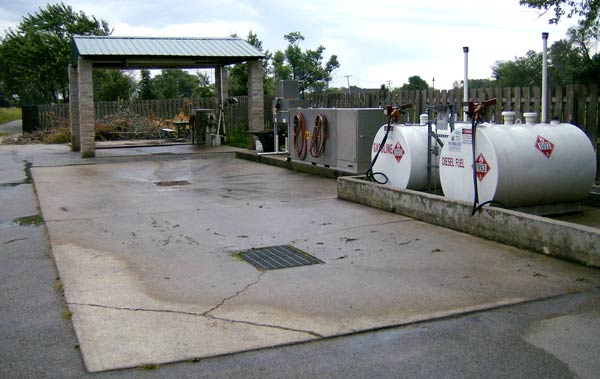
Managing Spill PollutionIn a very real sense, PDRMA members are environmental stewards for their communities. They manage publicly held natural resources so current and future patrons can enjoy fresh air, clean water and pristine trails and fields. As stewards, park superintendents have a special obligation to ensure the many chemicals needed to maintain parks and other outdoor recreational areas are handled and applied safely.
“All park superintendents tend to be environmentalists,” agrees Dave Ward, Superintendent of Golf at Coyote Run Golf Course at Homewood-Flossmoor Park District. “We manage large green spaces with birds, animals, frogs and other natural life. We see them all the time. Spill prevention is important to us because we don’t want to discharge any toxic materials or industrial pollution into the environment.”
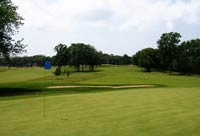  Maintaining the 140-acres (40 acres of Kentucky bluegrass roughs, 45 acres of bent grass greens, tees and fairways, 10 acres of ponds, and 20 acres of unmowed fescue being converted to native prairie vegetation) for the 18-hole course is a source of professional pride for Ward. “I’ve been a fan of native landscapes, and they are a feature of our golf course,” he says. “Unfortunately, most commonly used turf grass is susceptible to fungi, especially in hot weather. You can’t maintain a golf course in the Midwest without chemicals — once you get dandelions and clover, they take over,” says Ward. Maintaining the 140-acres (40 acres of Kentucky bluegrass roughs, 45 acres of bent grass greens, tees and fairways, 10 acres of ponds, and 20 acres of unmowed fescue being converted to native prairie vegetation) for the 18-hole course is a source of professional pride for Ward. “I’ve been a fan of native landscapes, and they are a feature of our golf course,” he says. “Unfortunately, most commonly used turf grass is susceptible to fungi, especially in hot weather. You can’t maintain a golf course in the Midwest without chemicals — once you get dandelions and clover, they take over,” says Ward.
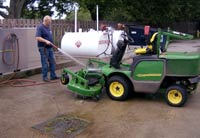  Although the chemicals have become less toxic and are used at much lower rates in recent years, fungicides and insecticides are still pollutants that must be handled carefully. Homewood-Flossmoor uses a concrete structure known as a rinsate pad to mix and load these chemicals and contain any spills or leaks. “Loading is the most hazardous procedure in spraying because of dealing with concentrated chemicals,” he says. “So we mix and load these toxins in the rinsate pad that easily holds the 230-gallon capacity of our largest spray tank. We train staff in proper handling, the use of personal protective protection and using a hazmat spill prevention plan. Spill containment kits — barrels with absorbent pads to soak up the chemicals and control the spill — are on hand as well.” Although the chemicals have become less toxic and are used at much lower rates in recent years, fungicides and insecticides are still pollutants that must be handled carefully. Homewood-Flossmoor uses a concrete structure known as a rinsate pad to mix and load these chemicals and contain any spills or leaks. “Loading is the most hazardous procedure in spraying because of dealing with concentrated chemicals,” he says. “So we mix and load these toxins in the rinsate pad that easily holds the 230-gallon capacity of our largest spray tank. We train staff in proper handling, the use of personal protective protection and using a hazmat spill prevention plan. Spill containment kits — barrels with absorbent pads to soak up the chemicals and control the spill — are on hand as well.”
Managing fungicides and insecticides are only part of pollution control for Coyote Run Golf Course. “We apply these chemicals periodically, but diesel fuel and gasoline are the most dangerous,” Ward notes, and grease, oil and other chemicals are released every time maintenance crews wash golf course equipment.
State and federal law considers the water from washing equipment an industrial waste discharge. “To drain that water into any body of water that leaves the property, you need an industrial waste discharge permit — a 30-page application that’s very expensive to file.” To keep these toxins out of the environment, Homewood-Flossmoor installed a wash-water recycling system that uses an unlikely ally to purify the water washed off the equipment: microbes.
After the grass clippings (used for compost) are separated from the equipment wash water, it goes through a recycler that uses microbes to decontaminate the water. “It is a closed system, and we use the same water all year,” Ward explains. “Every week we refresh the microbes. We use about 300 or 400 gallons a year with the water going through the honeycomb matrix of the microbes to be cleaned. This saves on our water bills, too.”
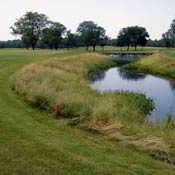  As an advocate of native landscapes, Ward uses a natural buffer to manage water as well — the five lakes on the course have vegetation buffers that filter chemicals and fertilizer from the run-off water during storms. Plants with extra long roots on the water’s edge prevent erosion and reduce the amount of pollutants carried by runoff. Frogs, birds and other animals also thrive in the additional habitat provided by the vegetation, including, unfortunately, intrusive and noisy Canada geese. The park has a “green” solution for that, as well: Wiley, the unofficial mascot of Coyote Run and the designated “goose dog” of the golf course, does his best to keep the geese on the run. As an advocate of native landscapes, Ward uses a natural buffer to manage water as well — the five lakes on the course have vegetation buffers that filter chemicals and fertilizer from the run-off water during storms. Plants with extra long roots on the water’s edge prevent erosion and reduce the amount of pollutants carried by runoff. Frogs, birds and other animals also thrive in the additional habitat provided by the vegetation, including, unfortunately, intrusive and noisy Canada geese. The park has a “green” solution for that, as well: Wiley, the unofficial mascot of Coyote Run and the designated “goose dog” of the golf course, does his best to keep the geese on the run.
Meanwhile, at Naperville Park District, the solutions are as varied as the agency itself. Home to 140 parks totaling more than 2,500 acres, with more than 1,400 different programs, the span of parks, programs, playgrounds, trails, athletic courts, sports fields, two golf courses, a beach and the Riverwalk use a variety of activities to keep things clean and green.
“Recently the Naperville Park District worked with Integrity Environmental to develop Spill Prevention, Control, and Countermeasure (SPCC) Plans for the district. The initial environmental surveys were conducted by an engineering firm hired by PDRMA’s pollution insurer,” says Kevin Finnegan, Director of Parks.
The plan was designed for the South Maintenance Complex and the above-ground fueling tanks, but was also a best practice measure for other fluids stored at the facility. “The plan changes helped to reduce spill exposures and improve safety and training in hazardous material handling and emergency response when specifically dealing with a hazardous spill,” notes Jennifer Herrmann, Safety Manager.
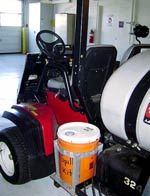  To keep toxic material out of the soil, the agency uses an organic-based hydraulic oil so if a line leaks in the field, the turf is undamaged. In addition, each of the park’s sprayers are equipped with spill kits to be used should a spill occur in the field on hard surfaces. All the agency’s park shops have spill kits to handle a fuel or other fluid leak. To keep toxic material out of the soil, the agency uses an organic-based hydraulic oil so if a line leaks in the field, the turf is undamaged. In addition, each of the park’s sprayers are equipped with spill kits to be used should a spill occur in the field on hard surfaces. All the agency’s park shops have spill kits to handle a fuel or other fluid leak.
“The engineer provided us with specialized plans for three facilities that require SPCC plans and also provided staff with training. This was very helpful, and it was necessary to work with a certified engineer,” Herrman explains. “It is nice to have a second set of eyes look at our facilities and processes.” Naperville also conducts annual emergency response training for staff.
Besides the hazardous material handling, SPCC plans and training, the agency has been actively involved in environmental initiatives. It has a Leadership in Energy and Environmental Design (LEED) certified maintenance facility with another LEED-certified building, the Knoch Knolls Nature Center, soon to follow.
A “Green Team” of park staff from all divisions ensures Naperville buys and uses green products, uses energy effectively, handles waste carefully and reduces waste when possible. Thanks to their efforts, the agency earned an Earth Flag award through the Earth Flag Certification Program, developed by the School and Community Assistance for Recycling and Composting Education Team to help businesses and organizations be more environmentally responsible by implementing practical, eco-friendly initiatives.
Preventing pollution is a high-stakes game in more ways than one. Groundwater contamination can last for years and is difficult to clean up; any incident with pollution going downstream can kill fish, hurt the environment, and incur huge losses and fines, as well as the cost and responsibility for clean up. Besides practicing good spill and pollution control practices, PDRMA members need to remember to add newly acquired property locations to pollution coverage, not only for new property purchased but also for property a member may be leasing long term. To add a property to your pollution coverage, log in to the PDRMA website, go to the Member Coverages menu, Property/Casualty, Member-Only Benefits and click the Add Property Location to Pollution Coverage. Be sure to remember to add the property to the AssetMaxx system as well.
PDRMA Resources
|

